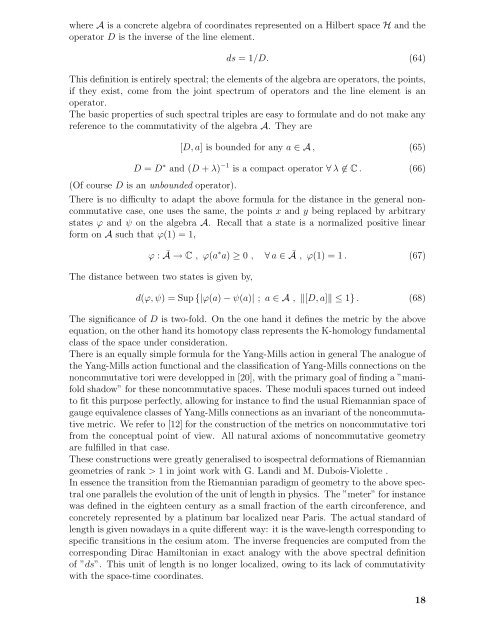Alain Connes (pdf)
Alain Connes (pdf)
Alain Connes (pdf)
You also want an ePaper? Increase the reach of your titles
YUMPU automatically turns print PDFs into web optimized ePapers that Google loves.
where A is a concrete algebra of coordinates represented on a Hilbert space H and the<br />
operator D is the inverse of the line element.<br />
ds = 1/D. (64)<br />
This definition is entirely spectral; the elements of the algebra are operators, the points,<br />
if they exist, come from the joint spectrum of operators and the line element is an<br />
operator.<br />
The basic properties of such spectral triples are easy to formulate and do not make any<br />
reference to the commutativity of the algebra A. They are<br />
[D, a] is bounded for any a ∈ A , (65)<br />
D = D ∗ and (D + λ) −1 is a compact operator ∀ λ ∉ C . (66)<br />
(Of course D is an unbounded operator).<br />
There is no difficulty to adapt the above formula for the distance in the general noncommutative<br />
case, one uses the same, the points x and y being replaced by arbitrary<br />
states ϕ and ψ on the algebra A. Recall that a state is a normalized positive linear<br />
form on A such that ϕ(1) = 1,<br />
ϕ : Ā → C , ϕ(a ∗ a) ≥ 0 , ∀ a ∈ Ā , ϕ(1) = 1 . (67)<br />
The distance between two states is given by,<br />
d(ϕ, ψ) = Sup {|ϕ(a) − ψ(a)| ; a ∈ A , ‖[D, a]‖ ≤ 1} . (68)<br />
The significance of D is two-fold. On the one hand it defines the metric by the above<br />
equation, on the other hand its homotopy class represents the K-homology fundamental<br />
class of the space under consideration.<br />
There is an equally simple formula for the Yang-Mills action in general The analogue of<br />
the Yang-Mills action functional and the classification of Yang-Mills connections on the<br />
noncommutative tori were developped in [20], with the primary goal of finding a ”manifold<br />
shadow” for these noncommutative spaces. These moduli spaces turned out indeed<br />
to fit this purpose perfectly, allowing for instance to find the usual Riemannian space of<br />
gauge equivalence classes of Yang-Mills connections as an invariant of the noncommutative<br />
metric. We refer to [12] for the construction of the metrics on noncommutative tori<br />
from the conceptual point of view. All natural axioms of noncommutative geometry<br />
are fulfilled in that case.<br />
These constructions were greatly generalised to isospectral deformations of Riemannian<br />
geometries of rank > 1 in joint work with G. Landi and M. Dubois-Violette .<br />
In essence the transition from the Riemannian paradigm of geometry to the above spectral<br />
one parallels the evolution of the unit of length in physics. The ”meter” for instance<br />
was defined in the eighteen century as a small fraction of the earth circonference, and<br />
concretely represented by a platinum bar localized near Paris. The actual standard of<br />
length is given nowadays in a quite different way: it is the wave-length corresponding to<br />
specific transitions in the cesium atom. The inverse frequencies are computed from the<br />
corresponding Dirac Hamiltonian in exact analogy with the above spectral definition<br />
of ”ds”. This unit of length is no longer localized, owing to its lack of commutativity<br />
with the space-time coordinates.<br />
18

















